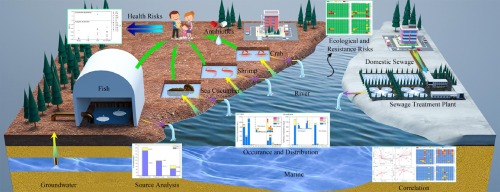Environment International ( IF 11.8 ) Pub Date : 2020-03-08 , DOI: 10.1016/j.envint.2020.105551 Q.F. Han , S. Zhao , X.R. Zhang , X.L. Wang , C. Song , S.G. Wang

|
This study focused on the distribution, combined pollution, potential source and risk assessment of 17 antibiotics in an aquaculture ecosystem surrounding the Yellow sea, North China. Antibiotics were detected in various matrices (seawater, sediment/biofilm, organism and feed) in different aquaculture modes (greenhouse and outdoor aquaculture) during the wet and dry seasons in coastal areas of Shandong province. The innovation points of the study were as follows: (1) To the best of our knowledge, this study was one of the few to investigate the occurrence and distribution of antibiotics in mariculture environments along the Yellow Sea coast; (2) Biofilms, a focus of the study, might act as a sink for antibiotics in the aquaculture ecosystem; and (3) The correlation of heavy metals and antibiotic concentrations was proved, which could correspondingly be used as an indicator for antibiotic concentrations in the studied area.
The levels of antibiotics in water were observed to be relatively low, at the ng/L level. Trimethoprim was the most prevalent antibiotic, and was detected in all water samples. Oxytetracycline was detected at high concentrations in biofilms (up to 1478.29 ng/g). Moreover, biofilms exhibited a higher antibiotic accumulation capacity compared to sediments. Concentrations of oxytetracycline and doxycycline were high in feed, while other antibiotics were almost undetected. Tetracycline was widely detected and the concentration of enrofloxacin was highest in organisms.
Correlation analysis demonstrated that environmental parameters and other coexisting contaminants (e.g. heavy metals) significantly affected antibiotic concentrations. In addition, the concentration of Zn was significantly correlated with the total antibiotic concentration and was proportional to several antibiotics in water and sediment (biofilm) samples (p < 0.01). High Mn concentrations were closely related to total and individual (e.g. sulfadiazine, sulfamethazine and enrofloxacin) antibiotic levels, which may result in the combined contamination of the environment. Antibiotics in estuaries and groundwater generally originated from aquaculture wastewater and untreated/treated domestic sewage. Most of the detected antibiotics posed no risk to the environment. Ciprofloxacin and enrofloxacin found in water may present high ecological and resistance risks, while the two antibiotics observed to accumulate in fish may pose a considerable risk to human health through diet consumption. All antibiotics detected in seafood were lower than the respective maximum residue limits. This study can act as a reference for the government for the determination of antibiotic discharge standards in aquaculture wastewater and the establishment of a standardized antibiotic monitoring and management system.


























 京公网安备 11010802027423号
京公网安备 11010802027423号